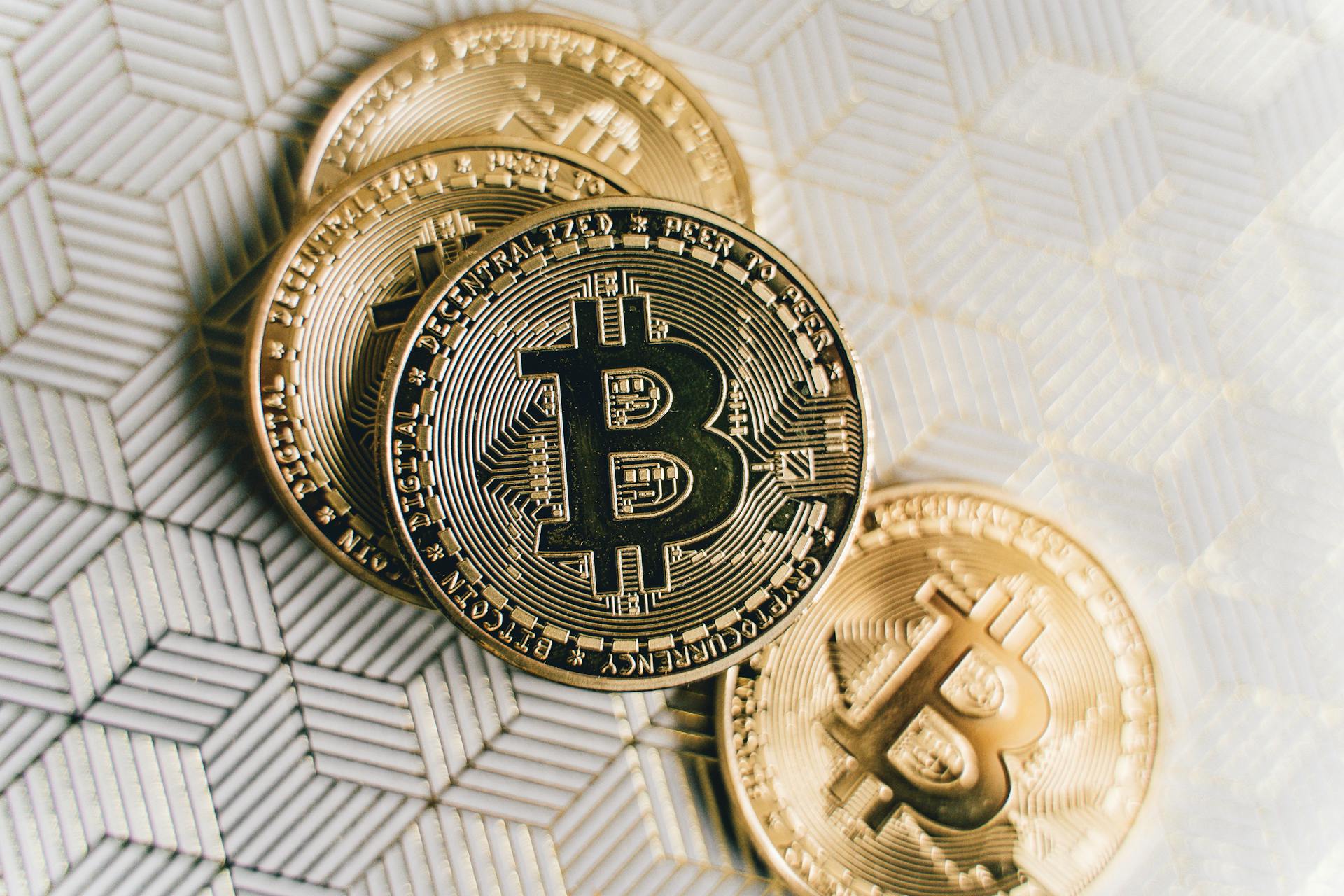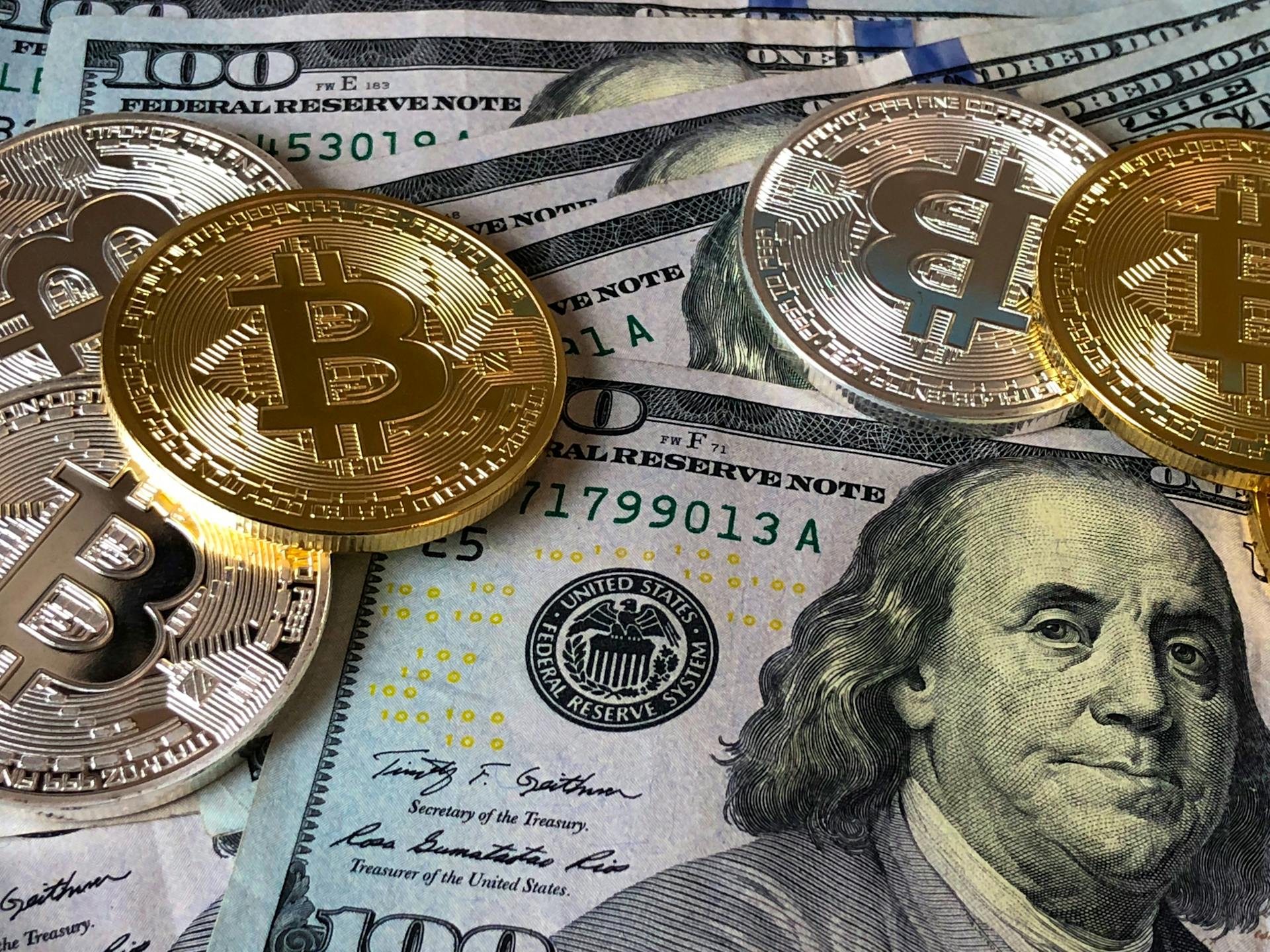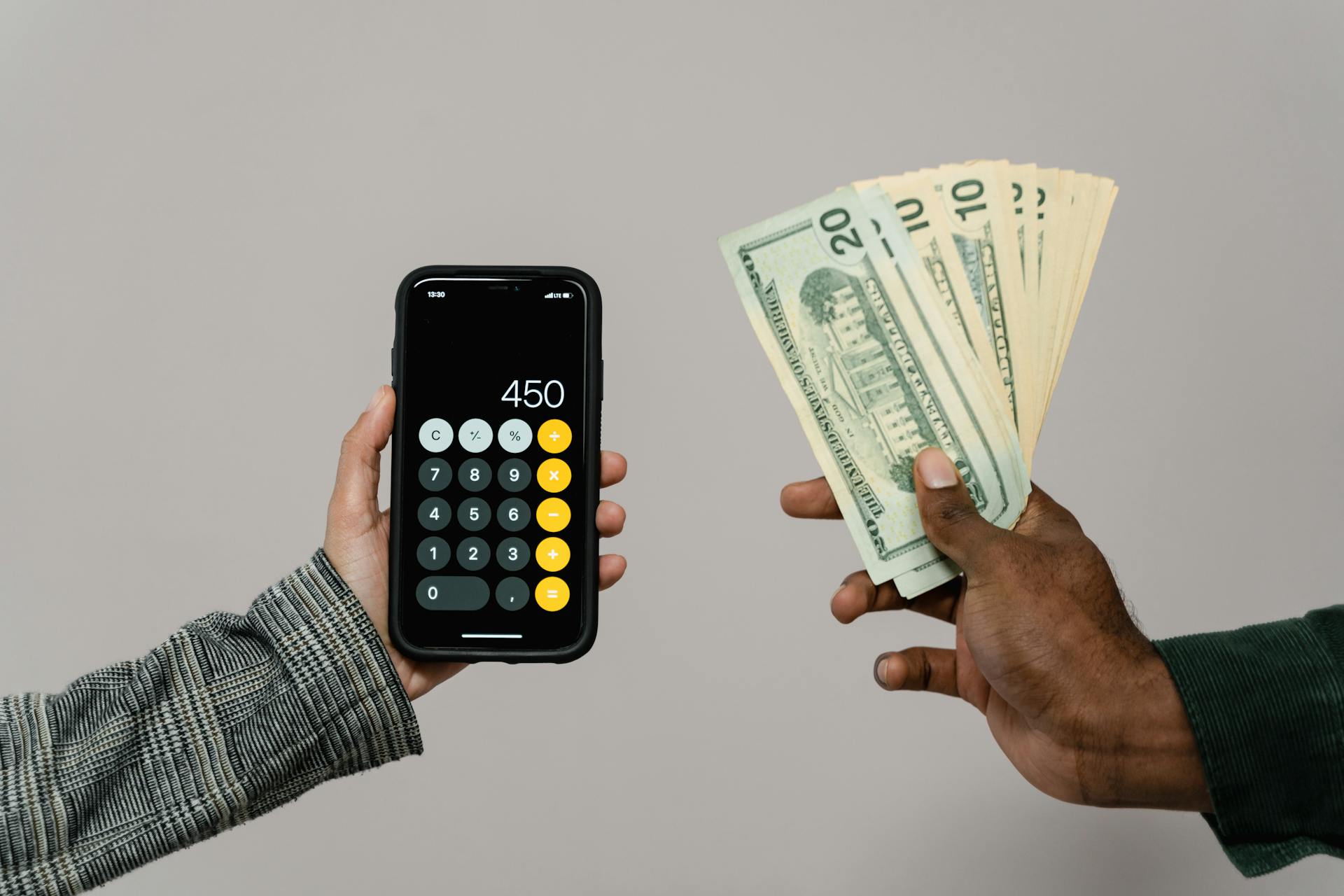
The concept of a maximum amount of Bitcoins is a crucial aspect of understanding the cryptocurrency. There will only be 21 million Bitcoins in existence, a cap that was set by Satoshi Nakamoto, the creator of Bitcoin.
This cap is a result of the way the Bitcoin network is designed, with a finite number of blocks that can be mined. The total number of Bitcoins is expected to be reached by the year 2140.
The finite supply of Bitcoins is a key factor in its value, as it creates a sense of scarcity and demand. This, in turn, can drive up the price of Bitcoin.
A different take: Bitcion Market Cap
What Is the Maximum Amount?
The maximum amount of Bitcoin is a crucial aspect of its monetary policy. The Bitcoin hard cap is set at 21 million BTC.
This hard limit on the total supply of Bitcoin is designed to create scarcity and prevent inflation. It's estimated that the last bitcoin will be mined around 2140.
Consider reading: An Airdrop of New Cryptocurrency following a Hard Fork Is
The hard cap is reached through the process of halving, where the reward for mining new blocks is cut in half approximately every four years. This gradual reduction in the rate of new bitcoin creation leads to the hard cap being reached.
The total supply of Bitcoin will reach 21 million when the hard cap is finally reached.
Take a look at this: Is Coinmarketcap Legit
Importance of the Cap
Bitcoin's hard cap is central to its value proposition, both as a store of value and an investment. This scarcity is one of the reasons why many investors value Bitcoin highly.
The halving process makes it difficult to increase the Bitcoin supply, and eventually, it will become impossible to create new Bitcoin. This scarcity is a key driver of Bitcoin's value.
The governance model of Bitcoin protects the hard cap, making it unlikely for the majority of nodes to adopt changes that would alter the rule. Any change to the hard cap would require widespread consensus.
Related reading: Bitcoins Intrinsic Value
The decentralized nature of Bitcoin's governance model means that changes to the protocol require agreement from tens of thousands of nodes. This makes it difficult to convince nodes to adopt changes to the hard cap.
Miners do not control the network or its rules, and they follow rules enforced by full nodes to be rewarded with Bitcoin. This means miners have no control over Bitcoin's ruleset.
The Blocksize War in 2017 demonstrated this, when 95% of miners agreed to raise the block size limit, but nodes and users refused this change.
You might like: Bitcoin Miners Ai Compute
Current Distribution and Ownership
The current distribution of Bitcoin is a topic of interest, with studies suggesting that approximately 6,952 BTC wallets control 58.21% of available bitcoins, meaning about 0.01% of the total BTC holders have almost 60% of BTC's supply.
The concentration of wealth in Bitcoin's distribution has been increasing over time, with only 1,840 wallets holding more than 50% of BTC's supply in 2012, compared to around 4,652 wallets in 2020.
Some of the largest individual Bitcoin owners include Satoshi Nakamoto, who mined roughly one million bitcoins between 2009 and 2010, and the Winklevoss twins, who have an estimated 70,000 BTC in their wallets.
Additional reading: Btc China
Importance of Ownership Distribution

The distribution of Bitcoin ownership is a crucial aspect of the cryptocurrency's success. It's essential to understand who holds the majority of the coins and why this matters.
Bitcoin's founder, Satoshi Nakamoto, envisioned it as an egalitarian P2P payment network. However, the current distribution of Bitcoin shows that large BTC holders, also known as whales, have an outsized influence on the crypto market.
Approximately 6,952 BTC wallets control 58.21% of available bitcoins, which means about 0.01% of the total BTC holders have almost 60% of BTC's supply.
The concentration of wealth in Bitcoin's distribution is a concern for some crypto advocates. They worry that banks and governments acquiring large shares of BTC could take over the network.
The biggest individual Bitcoin owners include Satoshi Nakamoto, the Winklevoss Twins, and Changpeng Zhao. Satoshi Nakamoto mined roughly one million bitcoins between 2009 and 2010, which are stored in 22,000 wallet addresses.
Here are some of the largest individual Bitcoin owners:
- Satoshi Nakamoto: 1,000,000 BTC
- Winklevoss Twins: 70,000 BTC
- Changpeng Zhao: Unknown, but estimated to be worth $96 billion
The concentration of wealth in Bitcoin's distribution is not as centralized as some other P2P cryptocurrencies, such as Dogecoin and Litecoin. However, it's still a concern for the future of the network.
Top BTC Exchanges
The top BTC exchanges are holding massive amounts of Bitcoin, and it's interesting to see who's leading the pack. Binance, the world's largest crypto exchange, has the largest single BTC wallet with 252,597 BTC.
Let's take a look at the top exchanges holding the most BTC:
Binance also owns two other cold storage addresses in the top 10 BTC wallets, with 143,314 BTC and 125,351 BTC. This gives us a sense of the scale of their operations.
Suggestion: Grayscale Bitcoin Trust Btc
Mining and Supply Limit
The time it takes to mine one bitcoin depends on the block reward, which is currently 3.125 bitcoins, and a new block is produced every 10 minutes. About 0.3125 bitcoins are mined per minute.
Mining fees will likely continue to be charged when Bitcoin's supply limit is reached, as miners will still need to verify transactions and open new blocks. This will increase the incentive for miners to process transactions.
Curious to learn more? Check out: Bitcoin Genesis Block
As of Dec. 22, 2024, 19.9 million bitcoins have been mined, leaving about 1.1 million bitcoins to be released. The total bitcoin supply is capped at 21 million.
The block reward given to miners is made up of newly-created bitcoins plus transaction fees. As the inflation rate goes to zero, miners will obtain an income only from transaction fees.
The price of block space, or "land", is set by demand for transactions and the mining difficulty adjusts around this to keep the average interval at 10 minutes.
Here's a rough estimate of the number of bitcoins that will be mined until 2140:
Note: This is an estimate and the actual number may vary due to factors like lost or inaccessible bitcoins.
Key Aspects of the Cap
The maximum total supply of Bitcoin is 21 million, but due to rounding operators in the Bitcoin codebase, the number of Bitcoins issued will likely never reach this limit.
The Bitcoin supply will eventually reach its upper limit, at which point no additional bitcoins will be generated. Instead, Bitcoin miners will likely earn income only from transaction fees.
The hard cap is central to Bitcoin's value proposition, making it a successful store of value like gold and real estate, due to its scarcity.
Here are some key aspects of the cap:
- The hard cap is protected by Bitcoin's governance model, which is decentralized and requires widespread consensus to make changes.
- Any change to the hard cap would require the majority of nodes to adopt the new rule, which is unlikely.
- Miners do not control the network or its rules, and nodes will reject blocks that violate the rules, making it difficult to change the hard cap.
There is a lack of an incentive to increase the bitcoin supply because it would result in inflation and destroy the core investment thesis for Bitcoin – its scarcity.
The Future of the Cap
Bitcoin's hard cap is a fundamental aspect of its value proposition, making it a successful store of value due to its scarcity.
The hard cap is protected by Bitcoin's governance model, which is decentralized, meaning that changes to the protocol require widespread consensus.
Changing the hard cap is possible, but it would require collaboration from developers, community members, and nodes, and would necessitate a hard fork.
Worth a look: Xrp Brad Garlinghouse Crypto Market Cap
After the maximum number of bitcoins is reached, no new bitcoins will be issued, but miners will still be rewarded with transaction processing fees.
The block reward given to miners is made up of newly-created bitcoins plus transaction fees, and as inflation goes to zero, miners will obtain an income only from transaction fees, which will provide an incentive to keep mining.
The price of block space is set by demand for transactions, and the mining difficulty readjusts around this to keep the average interval at 10 minutes.
With the current halving schedule, Bitcoin will not reach its cap until 2140, and the number of new bitcoins issued per block is decreasing by half approximately every four years.
The final bitcoin is not expected to be generated until 2140, or possibly earlier, due to the halving process, and the number of new bitcoins minted per block was 50 when Bitcoin was first established and has since decreased to 3.125 as of 2024.
A maximum of 21 million bitcoins can be minted, but it's likely that the number of bitcoins circulating remains substantially below that number due to lost or inaccessible private keys.
There will never be more than 21 million bitcoin because Bitcoin's hard cap is protected by its incentive and governance model, which has strong incentives to resist a change to the hard cap.
Suggestion: Coinbase Fees for Credit Card
Frequently Asked Questions
Can Bitcoin reach 1 million?
Bitcoin's long-term price projections suggest it could reach $1.77 million by 2050, but near-term expectations are more modest. While a $1 million price point is within the realm of possibility, it's unclear if Bitcoin will reach this level.
Why is Bitcoin 21 million limit?
The Bitcoin 21 million limit was set to combat inflation by preventing the supply of new coins from exceeding a finite amount, ensuring the value of each coin remains stable. This scarcity was achieved by Nakamoto's code, limiting the total number of bitcoins that can ever be mined.
Sources
- https://world.org/articles/popular-cryptos/who-owns-the-most-bitcoin
- https://www.investopedia.com/tech/what-happens-bitcoin-after-21-million-mined/
- https://river.com/learn/can-bitcoins-hard-cap-of-21-million-be-changed/
- https://en.bitcoin.it/wiki/Controlled_supply
- https://www.nerdwallet.com/article/investing/how-many-bitcoins-are-there
Featured Images: pexels.com


